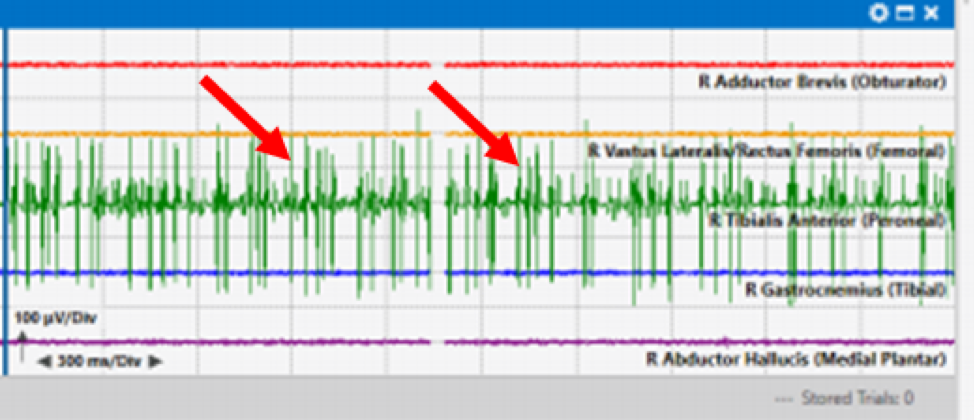Electromyogram (EMG) Monitoring During Lumbar Laminectomy and Decompression Surgery
October 30, 2020
Electromyogram (EMG) Monitoring During
Lumbar Laminectomy and Decompression Surgery
Faisal R Jahangiri, MD, CNIM, D.ABNM, FASNM, FASET
Axis Neuromonitoring, Richardson, TX, USA
Case Report
Patient History:
The patient was a 46-year-old female with a history of lower back pain and left leg weakness
admitted with a lumbar herniated disc at the L4-L5 level. Co-morbidities included high blood
pressure and Diabetes Mellitus. The patient was admitted for L4-L5 laminectomy and
decompression surgery.
Neuromonitoring:
Intraoperative Neurophysiological Monitoring (IONM) protocol included Somatosensory Evoked
Potentials (SSEP), Electromyography (EMG), and Train of Four (TOF).
Changes:
There was a significant abnormal Electromyography (EMG) activity noted in the tibialis anterior,
gastrocnemius, foot muscles bilaterally during the decompression stage. The surgeon was
immediately alerted of the abnormal EMG activity and waited for the EMG to subside. There
were multiple abnormal EMG alerts during the decompression procedures without any changes
in SSEP. At closing, EMG was quiet.

EMG activity in the right Tibialis Anterior muscle (red arrows)
Result:
The patient’s neurological exam was performed after the surgery for any deficits. No neurological deficits were present postoperatively.
Possible consequences without Neuromonitoring:
If abnormal spontaneous EMG was not identified on time by an intraoperative neuromonitoring technologist, it might have resulted in nerve roots damage. Hence, the patient would have post-operative muscle weakness, numbness, severe pain, or foot drop, etc.
References:
- Jahangiri FR, Sheryar M, Al Behairy Y. Early detection of pedicle screw-related spinal cord injury by continuous intraoperative neurophysiological monitoring (IONM). Neurodiagn J. 2014 Dec;54(4):323-37. doi: 10.1080/21646821.2014.11106817. PMID: 25675703.
- Jahangiri FR, Asdi RA, Tarasiewicz I, Azzubi M. Intraoperative Triggered Electromyography Recordings from the External Urethral Sphincter Muscles During Spine Surgeries. Cureus. 2019 Jun 10;11(6):e4867. doi: 10.7759/cureus.4867. PMID: 31417812; PMCID: PMC6687425.
- Eager M, Shimer A, Jahangiri FR, Shen F, Arlet V. Intraoperative neurophysiological monitoring (IONM): lessons learned from 32 case events in 2069 spine cases. Am J Electroneurodiagnostic Technol. 2011 Dec;51(4):247-63. PMID: 22303776.
- Parker SL, Amin AG, Farber SH, McGirt MJ, Sciubba DM, Wolinsky JP, Bydon A, Gokaslan ZL, Witham TF. Ability of electromyographic monitoring to determine the presence of malpositioned pedicle screws in the lumbosacral spine: analysis of 2450 consecutively placed screws. J Neurosurg Spine. 2011 Aug;15(2):130-5.



